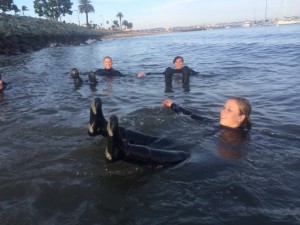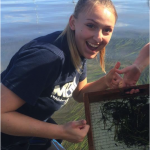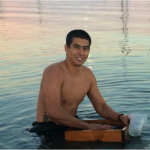A buoyant day in the field
by Whitney Dailey (San Diego State University undergraduate, ZENtern)
One of my favorite parts of the ZEN seagrass ecosystem ecology course at San Diego State University this past spring semester was working in the field and learning about seagrass ecology through a hands on approach.
One field day that I will never forget was when we were collecting our predation intensity experiment. The experiment consists of deploying several “tethers”, which are made by gluing grazers (in this case small grass shrimp or snails) to fishing line placed out in the seagrass bed. We then come back later to record whether the animals have been eaten. The purpose of the experiment is to understand the level of predation in the environment and the relatively susceptibility of different types of grazers.

Whitney and classmates at SDSU learn the importance of being prepared for the unexpected – and in bringing weight belts out into the field
However, one of the main lessons that we learned during our time in the field with the ZEN class is that every experiment has its own challenges and the trick is to problem solve and find a way around it. On this particular field day we met the challenge of trying to schedule fieldwork around both our class schedule and the tide. For us this meant struggling to find the tethers in around 3 to 4 feet (1-1.5 meters) of water. While this may not sound challenging, we found it to be very difficult. We would try to dive down, but the extra buoyancy from our wetsuits at that shallow depth made us pop up to the surface right away. So, we just floated on the surface and would reach down and try to find them and pull them out. The trick was not giving up, and remembering to bring a weight belt in the future.
After many failed attempts of trying to retrieve the tethers, we were finally able to hold onto the pieces of rebar we’d installed to mark our experimental plots, and feel around until we found the tether and pulled it out. Every time we found a tether we would get so excited – until we moved on to retrieve the next one. But, with a lot of commitment and perseverance we completed our field day at our ZEN site in San Diego Bay and learned new methods for problem solving during fieldwork. We also learned that in marine ecology (and likely the other sciences) the truly exciting part comes from overcoming challenges, even the ones you didn’t anticipate!
Whitney graduated summa cum laude this May from San Diego State University, receiving her Bachelors of Science in Biology and Environmental Science. She has been working in seagrass ecology as part of Dr. Kevin Hovel’s lab for the past four years including on the initial ZEN projects in 2011-2012. Hailing from Washington, Whitney enjoys playing basketball and taking photographs in her spare time. This fall she plans to being a job as a research technician before applying to graduate school. Whitney will be traveling to work with Dr. Per-Olav Moksnes and his research group in Sweden as par of her ZENternship this summer.
Loving science for the challenge
by Christopher Bayne (San Diego State University undergraduate, ZENtern)
Field days have to be one of my favorite parts of science for two main reasons. The first reason is fairly obvious – we get to go out to the field site, which means getting some exercise, being in the sun, and working in the natural environment. You can’t beat that! The second reason is less intuitive. I really enjoy the challenges of fieldwork and problem solving. No matter how well protocols are planned and how many times you go over them, it seems that the smallest thing can turn into the biggest pain. Even though these problems can be time consuming and counterproductive, they keep you on your toes.
Along those lines, the ZEN predation intensity experiment comes to mind. The first time we deployed the experiment, which tested different materials as potential standardized prey to be used in experiments conducted by all of the ZEN partners, we used braided line threaded through different bait types. We separated each bait into separate bags for “quick and easy” deployment in the field. However, when we reached our field site we soon discovered that, when braided line goes into a bag, the mixture of moving around, getting wet, and Murphy’s law results in a knot so bad that you can barely distinguish one line from another. It just so happens that this occurred to six of our eight different bait types. What do we do?
We approached the problem like you do with so many other unexpected field issues. You accept it and just jump in headfirst. You approach the knot and honestly, there is no apparent advantage of coming at it at any certain way. You just begin trying to separate each line one at a time. You try different things: weaving the bait end through, loosening the most knotted sections, pulling the line through slowly. You swear you’ve undone hundreds of knots yet the ball of tangled string never looks as if any progress was made. Finally, you notice one looks as if it is almost loose. You put all your effort into that and get it out with this silent victory to yourself. Eventually they are all loose and you re-wrap them in a way that they will not get tangled up again. You think about what you could or should have done to avoid this mess. You finish up what needs to be done, knowing you are ready for whatever comes next.
In the end, the problem of the knotted line may be small but it is symbolic of the problems researchers face all the time. Little complications creep out of nowhere, completely unexpected. You try a million different solutions and begin to loose faith when nothing seems to work. If you have enough patience, the knot will eventually loosen and you will be victorious, swearing that you will never make that mistake again. This is why I have chosen to do science. It is challenging in so many ways. Learning the correct terminology, setting up experiments, finding solutions to unexpected problems – these are just some of the reasons why science is challenging and yet very rewarding.
Working on a project as large as ZEN adds an additional level of complexity in both coordinating large teams of people distributed all over the globe. This summer I will be travelling to Japan to work with the ZEN partners in both Akkeshi and Hiroshima. It is an amazing opportunity that not many undergraduates get to be a part of. I am looking forward to all of the challenges I will be facing this summer. I’m sure there will be more than a few but, if I’ve learned my lesson, tangled fishing lines will not be one of them!
Chris is a rising senior at San Diego State University pursuing his bachelor’s in biology and Japanese. Before starting the ZEN program Chris worked with Dr. Violet Compton Renick on her dissertation research examining the interactive effects of parasites and pesticides on killifish behavior. During the SDSU ZEN course Chris led a feeding experiment where he measured the grazing rates of several different types of San Diego mesograzer. This summer Chris will be traveling as part of his ZENternship to Japan to assist Drs. Massa Nakaoka and Massakazu Hori.




